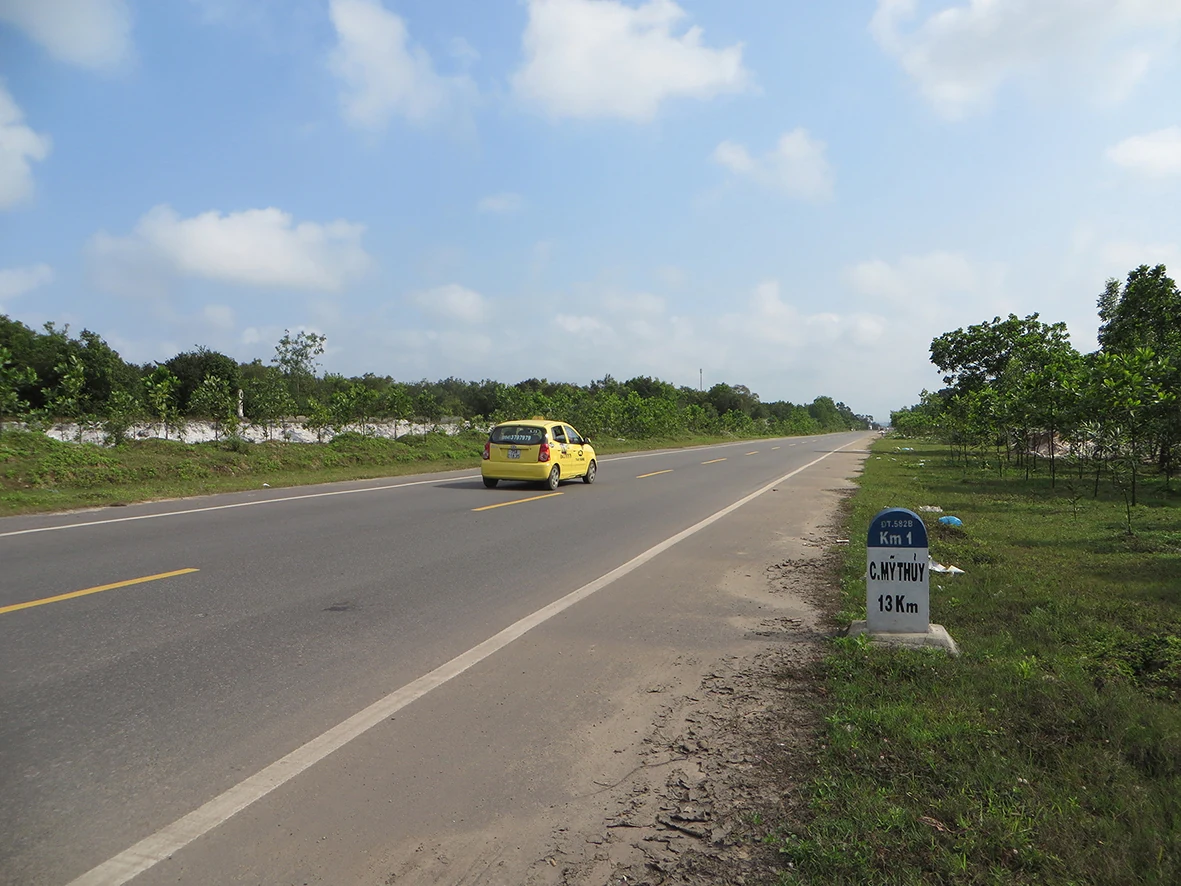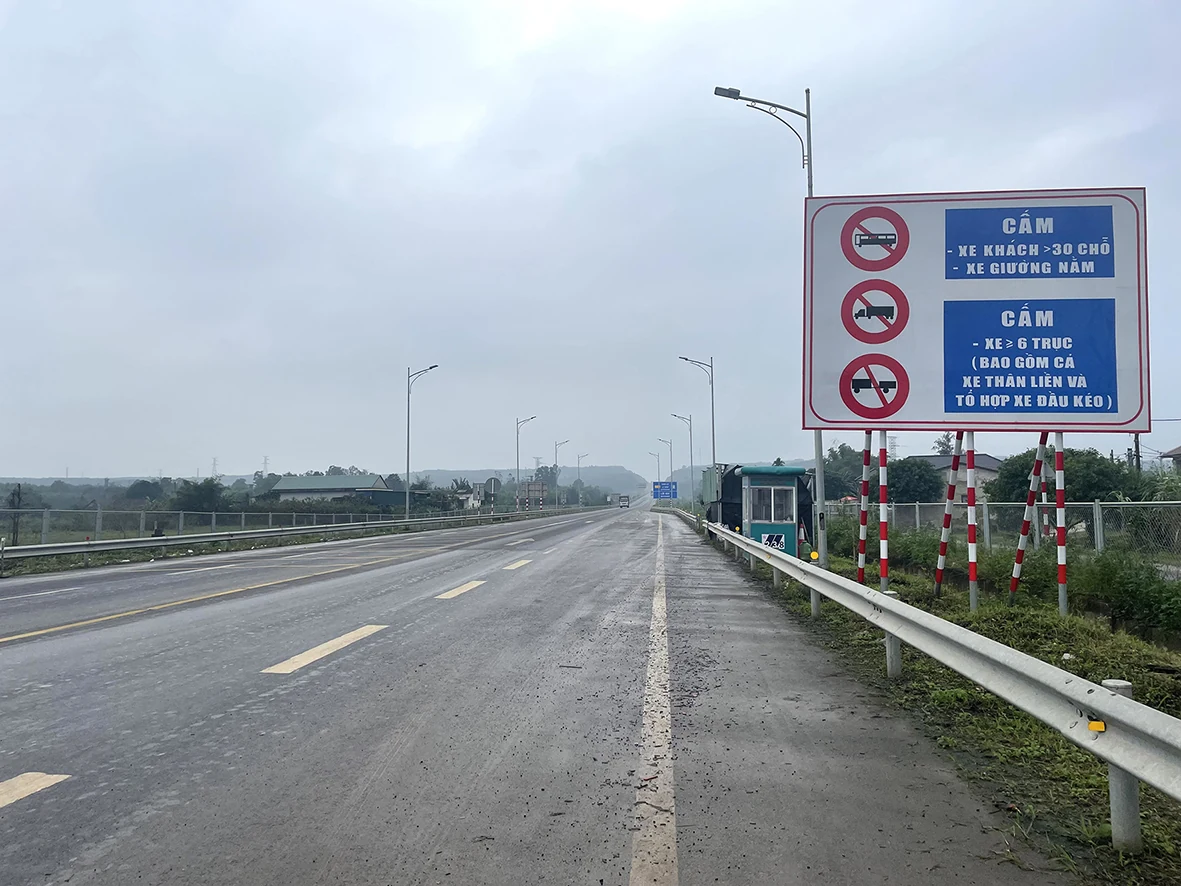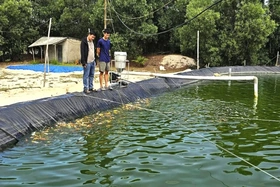{title}
{publish}
{head}
Currently, the construction of National Highway 15D is regarded as the most critical project among key initiatives to establish seamless connectivity from forest to sea. This project aims to unlock cooperation opportunities along the PARA-EWEC economic corridor, linking Quang Tri province with southern provinces of Laos and Thailand.
On December 25, 2024, Nguyen Long Hai, an Alternate Member of the Party Central Committee and Secretary of the Quang Tri Provincial Party Committee, visited the La Lay International Border Gate to assess the progress of investment projects, including the construction of National Highway 15D and the coal transportation conveyor system from Laos to Vietnam. This visit underscores the provincial leadership’s strong commitment to advancing this vital highway for socio-economic development in Quang Tri.

Road leading to My Thuy Port, Hai Lang District. Photo: D.T
On the occasion of the 93rd anniversary of the birth of General Secretary Le Duan (April 7, 1907 - 2000), Mr. Dong Ngac, former assistant to General Secretary Le Duan, recorded the ideas of Comrade Le Duan about a modern Truong Son road. His account was published in the Nhan Dan newspaper.
According to the article, in 1973, after the signing of the Paris Peace Accords on Vietnam, Comrade Le Duan visited the Truong Son Army Corps. In the unit’s golden book, he wrote: "The Truong Son road is a shining achievement in the history of our nation’s resistance against the United States to save the country. The Truong Son road is the road of willpower, courage, and heroic spirit. It is the road connecting the North and South, unifying the nation; it is the road of our nation’s prosperous future..."
Mr. Dong Ngac noted that two phrases were underlined. However, at that time, the focus was often on the strategic role of the Truong Son road in the latter stages of the resistance war, and few recognized General Secretary Le Duan’s vision of transforming the road from one serving wartime needs into "a road of our nation’s prosperous future."
In 1977, during a journey from Hanoi to Ho Chi Minh City by car to survey conditions in several southern provinces after liberation, Comrade Le Duan discussed the need to upgrade National Highway 1 and, in the future, rebuild the Truong Son road into a complete and modern trans-Vietnam highway parallel to National Highway 1, ensuring uninterrupted economic connectivity between the North and South.
As part of the development process, many cross-roads should be constructed, like steps connecting coastal towns and cities in the east with economic and cultural centers to be developed in the midlands and western mountainous regions. General Secretary Le Duan conveyed this idea to comrades Phan Trong Tue and Dinh Duc Thien, who were Central Committee members in charge of transportation. During his visits to the central provinces in subsequent years, General Secretary Le Duan consistently emphasized that these provinces had three advantageous regions: lowlands, coastal areas, and mountains. Thus, economic and cultural recovery and development plans must effectively exploit the lowlands, while also focusing on developing the maritime economy, coastal regions, and expanding economic activities in the midlands and mountains.
Efforts must focus on utilizing land and labor resources to progress, seeking ways to gradually transform economic and agricultural structures while redistributing the labor force appropriately in each region. (Source: “Building Binh Tri Thien into a Prosperous Province,” Thuan Hoa Publishing House, 1982, pp. 48-49).
Mr. Dong Ngac shared that during his visits to the central region, General Secretary Le Duan requested arrangements to travel along portions of the Truong Son road, such as from Thanh My to Kham Duc (Quang Nam - Da Nang) or from Dakrong to A Sau and A Luoi (Binh Tri Thien). However, due to poor road conditions and security concerns at the time, provincial leaders could not arrange this. They only managed to take General Secretary Le Duan on a short 15-kilometer section of the eastern Truong Son road from Dakrong Bridge southwards before returning via Highway 9 to Hue.

When National Highway 15D is opened, it will connect conveniently with the Cam Lo - La Son Expressway - Photo: D.T
In General Secretary Le Duan’s vision, the modern Truong Son road would serve as the second trans-Vietnam highway, the foremost economic and social artery, propelling Vietnam out of poverty and backwardness while ensuring national defense and security in the new era. This vision was conceived during the most intense years of the resistance against the United States.
The current construction of National Highway 15D in Quang Tri Province stems from the pressing practical needs for socio-economic development and international economic integration but also brings to life the vision of General Secretary Le Duan nearly 50 years ago: "As development progresses, many cross-roads should be opened like steps connecting coastal towns and cities in the east with economic and cultural centers to be developed in the midlands and western mountainous regions."
Following the establishment of the Southeast Economic Zone, one such “step” identified for initiation is National Highway 15D, linking the La Lay International Border Gate (Dakrong) to My Thuy Seaport (Hai Lang).
The National Highway 15D investment project spans approximately 92 kilometers. Of this, the section from My Thuy Seaport to National Highway 1 is 13.8 kilometers long, and the provincial People’s Committee has requested central support for upgrading it, with an estimated investment of VND950 billion, already approved in principle by the Ministry of Transport. The 8-kilometer section from National Highway 1 to the Cam Lo - La Son Expressway is proposed for public investment with support from central government revenue surplus for 2024, estimated at VND990 billion. The 34-kilometer segment from the Cam Lo - La Son Expressway to the western branch of the Ho Chi Minh Highway is under preliminary feasibility study through a public-private partnership (PPP) with a total investment of approximately VND 5.662 trillion, seeking state funding support of VND2.55 trillion.
Surveying the two main routes to the La Lay International Border Gate shows that on the Lao side, Route 15B connects the border gate to Salavan provincial center and further to Pakse City, Champasak Province (a socio-economic hub in southern Laos). Route 15B, running nearly 147 kilometers from Salavan to the border gate, was upgraded by the Lao government with an investment of about USD 200 million, featuring a 9-meter roadbed, an 8-meter-wide paved surface, and completed in early 2013.
Thus, transportation along the two primary routes to the La Lay International Border Gate has been improved, facilitating connections between northeastern Cambodia, eastern Thailand, southern Laos, and central Vietnam via the La Lay International Border Gate to Quang Tri Province.
The establishment of an additional PARA-EWEC corridor from Ubon Ratchathani (Thailand) through Champasak (Laos), via the La Lay International Border Gate to Quang Tri Province, represents an important international route complementing the East-West Economic Corridor (EWEC). The La Lay International Border Gate will thereby supplement Lao Bao International Border Gate, creating mutual support between the two corridors, EWEC (via Lao Bao) and PARA-EWEC (via La Lay).
When the Southeast Economic Zone of Quang Tri is developed, constructing National Highway 15D from the La Lay International Border Gate to My Thuy Seaport will shorten the current route by about 80 kilometers. Regarding General Secretary Le Duan’s vision to "focus on developing the maritime economy, coastal regions, and expanding economic activities in the midlands and mountains...finding ways to gradually transform economic and agricultural structures while redistributing the labor force appropriately for each region," the potential for effectively exploiting land resources across vast areas of the province, from southwestern Dakrong and southern Cam Lo to southeastern Hai Lang and Quang Tri town, will become evident with the opening of National Highway 15D.
The significance of this highway also lies in enabling the smooth transport of millions of tons of goods annually from Laos and Thailand to Quang Tri and beyond to other Vietnamese provinces or international destinations through central seaports, including My Thuy Seaport in the Southeast Economic Zone of Quang Tri. This will be especially vital when the coal conveyor system from Laos to Vietnam is operational.
Additionally, the Cam Lo - La Son Expressway section through Quang Tri, 37 kilometers long, currently lacks cross-connections to National Highway 1. This inconvenience could cause traffic disruptions on the expressway in case of accidents or natural disasters, complicating rescue, evacuation, and traffic clearance between the two routes. With National Highway 15D, these issues will be effectively addressed.
National Highway 15D is considered a hopeful route, playing the role of “unlocking the bottleneck,” creating a clear pathway from La Lay to National Highway 1 and My Thuy Seaport in the Southeast Economic Zone of Quang Tri, thereby promoting socio-economic development in Quang Tri Province and the entire central region. Its prompt implementation is essential.
Dan Tam - Ngoc Mai

QTO - In Quang Tri, clean agricultural stores may not flaunt flashy signs or wide storefronts, but they are quietly becoming trusted places where consumers...

QTO - In a quiet village in central Vietnam, Le Minh Duc, 26, has turned his passion for ornamental fish into a promising startup, the first Koi breeding...